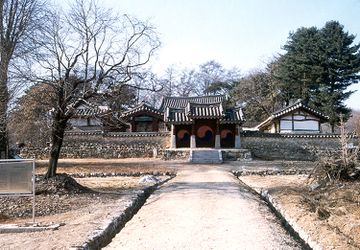충렬사(인천)
| 충렬사 Chungnyeolsa Shrine |
|
| 대표명칭 | 충렬사 |
|---|---|
| 영문명칭 | Chungnyeolsa Shrine |
| 한자 | 忠烈祠 |
| 주소 | 인천광역시 강화군 충렬사로 232 |
| 지정(등록) 종목 | 인천광역시 유형문화재 제21호 |
| 지정(등록)일 | 1995.03.02 |
| 분류 | 유적건조물/종교신앙/민간신앙/기타 |
| 시대 | 조선 |
| 수량/면적 | 1동 |
|
|
|
해설문
국문
병자·정축호란(1636~1637) 당시 종묘의 위패를 받들고 세자빈과 원손을 수행하여 강화도로 피난하였다가 강화가 함락되었을 때 순절한 김상용(金尙容)을 비롯하여, 병조판서 이상길, 장령 이시직, 돈녕도정 심현, 천총 구원일 등을 배향한 사당이다. 인조 19년(1641) 건립하여 현충사라 하였으나 효종 9년(1658)에 임금이 유수 허휘에게 현판과 전답을 내리면서 충렬사로 개칭하였다. 당초에는 유생들이 수련하던 명륜당과 기거하면서 공부하는 동재, 서재가 있었으나 없어졌다. 현재는 사당, 외삼문, 대문의 양측에 설치된 수직방, 제사 때 제수 용품을 준비하던 전사청, 비각 등이 남아 있다.
- 병자호란 때의 충신 28명의 위패를 봉안한 곳
- 1871년 흥선대원군이 서원철폐령을 내렸을 때 정리대상에서 제외된 서원 중 하나이다. 그만큼 조선시대 충절의 상징으로 주목받던 곳이다.
- 현재의 건물은 1977년 보수하였다
영문
This shrine commemorates 28 loyal patriots who died during the Manchu invasion in 1636 and 1637. Among them is Kim Sang-yong (1561-1637), who moved the spirit tablets of previous Joseon kings from the royal shrine in the capital, Hanyang (present-day Seoul), to Ganghwado Island for protection. He also escorted royal family members to take refuge here. However, when Ganghwado fell to the enemy, Kim committed suicide.
The shrine was first established in 1641. In 1658, King Hyojong (r. 1649-1659) bestowed the name "Chungnyeolsa (忠烈祠)," literally meaning "Shrine of Loyalty and Faithfulness." In the late 19th century, many shrines were shut down by a nationwide decree, but this shrine survived as it was regarded as a symbol of loyalty. The current buildings were repaired in 1977.
참고자료
- 강화성 남문에서 산화한 김상용과 병자호란의 순절자들 충렬사, 『서울, 경기, 인천 문화유산 이야기여행』, 문화재청, 2013.
